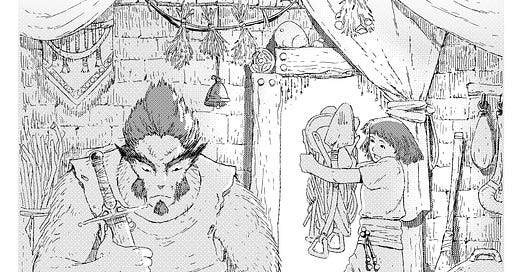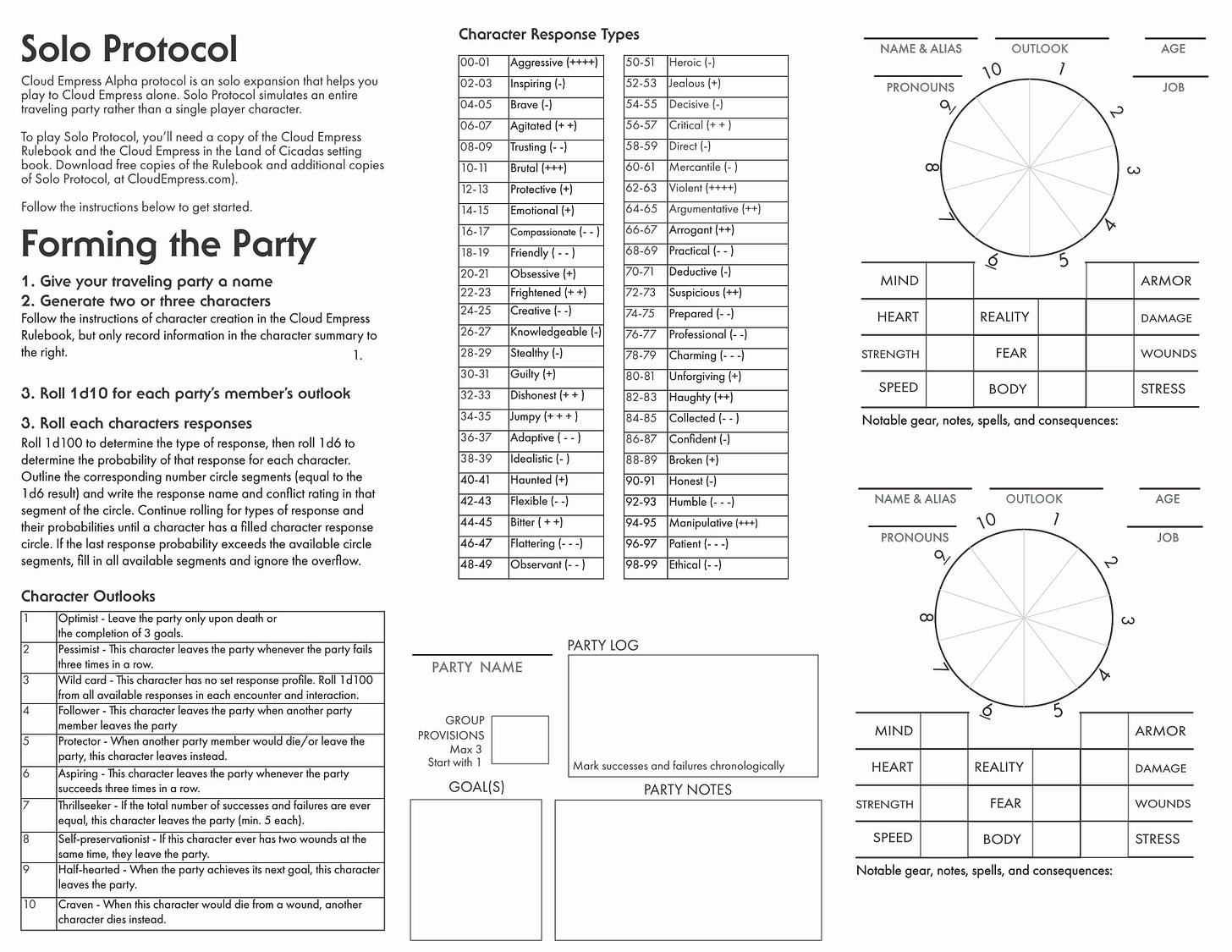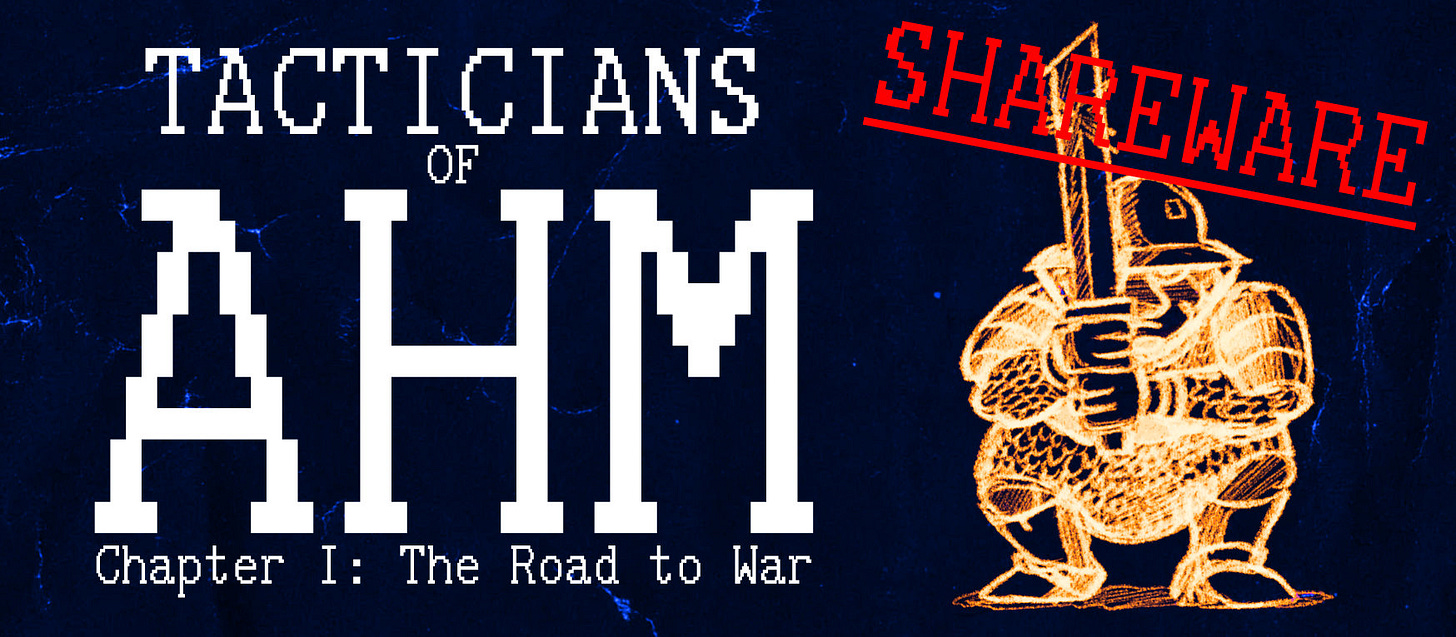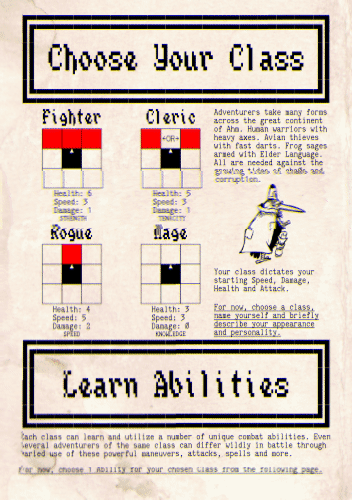Preorders close June 14th
If you haven't secured your copy of Cloud Empress, preorders close on June 14th. Understanding the total number of orders will allow me to finalize production numbers as we move closer and closer to production (expected July 2023).
Preorder your copy of Cloud Empress today!
Cloud Empress Development Discord
Want to start playing Cloud Empress? I've set up a Cloud Empress Development Discord to answer rules questions, and playtest Cloud Empress. Folks have also shared opportunities to join games of Cloud Empress, both in-person and online. Click this link if you'd like to join the Discord.
(If you're reading this newsletter after 7 days of its posting, email worldsbywatt@gmail.com for a Discord invite.)
Draft Solo Rules
Today I posted the first draft of the Cloud Empress solo rules in the Discord server - the "Solo Protocol." I've wanted to create a unique and accessible solo experience for Cloud Empress since the project's start. Solo Protocol simulates the interactions of an entire party of travelers. Each character gets a set of randomly generated responses. The gameplay experience is a bit like playing the Sims, where you have a limited control over the characters. You roll to find out how your group responds to encounters and interactions. To play Solo Protocol requires imagination and creativity to fill in the gaps, but the pamphlet should provide enough mechanical and random elements to create feelings of unpredictability and spark moments of emergent storytelling. If you'd like to playtest Solo Protocol, join the development Discord today (see the link above)!
Interview with Christian Sorrell A.K.A. Meatcastle
I’m talking with Christian Sorrell, known as MeatCastle, about his game development work on Cloud Empress, Ultimate Badass, and his upcoming game Tacticians of Ahm. Over the last two months, I’ve hired Christian to review Cloud Empress’ mechanisms, kick the tires with some playtest sessions, and dig into all the math behind the rule changes I’ve made to the Mothership system.
First, can you tell me where the name Meatcastle Gameware came from? It’s such a goofy name, and very memorable. Sometimes when I’m sending invoices or doing tax stuff I think about how funny these tasks would be with Meatcastle on the name of the paperwork.
Oddly enough, it’s actually a name with a real world story to it, not just a random screen name I picked that ended up being my online brand. I was in a hardcore punk band years ago and our drummer, a very small woman, was standing next to me outside of the show before we were set to go on and just looked up at me, a very tall and big person, and just out of nowhere said: “You are so big. You are like a castle… of meat.” So that cracked us all up and it instantly became my new name on everything. When it came to starting the business side of my games work, everyone already knew me online as Meatcastle so I just leaned into that and combined it with my lifelong love of video games to make something that sounds like a 90s company making Sega Genesis games.
It’s been great working with you on the game development and game mechanisms of Cloud Empress. One of the reasons I specifically reached out to was your work on Ultimate Badass. How would you describe Ultimate Badass to someone unfamiliar with it? What was the development of Ultimate Badass like?
Ultimate Badass is a set of action movie-inspired rules changes and table tweaks for Mothership 1e that makes the characters more capable, the action more bombastic, and the Panic and Wounds more over the top across the board. If Mothership is Alien (1979), Ultimate Badass is Aliens (1986).
Development on UB was very fun. It was my first mechanics-heavy TTRPG product I put together, having done mostly adventure writing beforehand. The biggest change in my typical development/writing cycle was adding lots more playtesting. I definitely believe that adventures can and should be playtested if the creator is able, but there’s a lower limit to how useful and effective those playtests become (especially with more open-ended systems/game styles). Since so much of UB was about tweaking numbers to shift player success chances and outcomes around panicking and wounds (more options on both could actually help/empower your character), I wanted to see how this came out in play, and due to the random nature of tables and character stats, I needed to get as many examples of that as possible. I ran several playtests myself, and it was my first product that I had other outside playtesters take on. All told, I believe I had 4-5 separate groups all play through several sessions using the UB rules which really gave me great feedback to refine the core changes, replace unused perks, and more.
As someone involved in a few Mothership rules hacks, what advice would you give to someone interested in hacking an existing rules system like Mothership (or Cloud Empress when it comes out)?
I think the most important thing about any rules hack is having a clear goal in mind for the change you want to me and then making sure that you are changing as few rules as possible in order to achieve that goal. Any time you are adding to the mental load of the players (especially when they are playing in an existing system they are already familiar with), the more that is there the more likely it is to be forgotten, overlooked, or applied incorrectly or inconsistently.
For Ultimate Badass, I focused on having the majority of the changes be on the stats and table backend rather than changing any of Mothership’s primary rules. This lets players simply mark different numbers on their sheet at character creation and refer to a tweaked table when panicking or taking a wound, but otherwise, they get to play Mothership and then they feel the difference in play without needing to learn new rules. The perks were the one new rule/mechanic and even then, I focused on making them as simple to use and remember as possible: You can use them X times per session or encounter and they either work automatically or call for a rule in standard Mothership rules language.
It’s very easy with game design (like most creative work) to let your scope creep and to overdesign or overwrite things. If 90% of your goal can be achieved with a single rules change but getting the final 10% takes a half dozen other changes, it’s always better to stick with the single 90% change and cut the rest.
In the last year, you’ve gone full-time as a game creator and freelance editor/game developer. Working freelance, how do you approach a new project you’re hired to work on?
My approach is a bit different depending on the type of work I’m doing on a project since I do editing, development, and adventure writing work as part of my freelancing.
For editing, I try to come to a manuscript as fresh as possible so that I am able to analyze the text from the standpoint of an outside reader. Does the text stand alone in a way that supports play? Are there questions the reader is likely to have that the text does not answer? Does the structure of the overall text facilitate learning and ease of use? Additionally, I make sure to brief myself on the standard style and notation of the game and build towards consistency between something like a third-party adventure and a first-party game rules book. Those little things like how a stat block is notated or how damage is listed all add up to make a supplement feel like a companion to a game or a game of its own, rather than homebrew notes and rule hacks.
For development, I do a clean initial pass on the existing portions of a project, often before discussing too in-depth with the project lead, in order to get an outside perspective on the strengths and weaknesses of the project so far, the standout elements, the atmosphere and vibe it aims to create, etc. From there, I’ll chat with the project lead on their goals for my role in the project. Development can take dozens of different forms (stats and probabilities, roll mechanics, sub-systems like encumbrance or hexcrawl rules, etc.) so making sure I’m focusing my attention in the right spots is key. Then, I do additional passes (and sometimes playtesting), digging into the areas I see the project veering away from the designer’s intention and working to shift them more in line with the overall project vision. Sometimes, this is a simple suggestion and at other times, it’s more involved - calculating out minimum and maximum possibilities, average probabilities, offering replacement mechanics, and more. Reading and referencing similar works in the space as well as a project’s biggest influences can also be very helpful.
For adventure writing, I start from a similar mindset to development. What is unique about the system I am writing for in particular and how can I shape an adventure to lean into those elements? Additionally, I’ll often ask the project manager why they came to me for the adventure writing (essentially, what do they see as my unique qualities that they want employed in the work). From there, I build my idea out to fit the scope of the project as a rough outline and then I build out the chunks of that outline from there. Focusing on the system’s and the writer’s strengths, I’ve found, tends to make for more interesting and memorable work. I want my adventure to get players excited to play a system and for the system to make players excited to play my adventure.
Working on Cloud Empress together, I’ve appreciated how you quickly honed in on the unique gameplay and thematic experiences Cloud Empress can create. As a creator, a bit lost in my work at the moment, it felt like a guiding light as I finalized some of the last rules hacks. Can you describe the unique gameplay experiences that are waiting for folks in the Cloud Empress rules from your experiences with the game?
Cloud Empress has a heart, a kindness, a humanity to it that immediately struck me. It’s a harsh world with dark and terrifying things in it, but the game itself is just as much about the party enjoying a good meal over a campfire or bartering to stay overnight in a farmer’s barn as it is about navigating those dark dangers. These two elements, reinforced by your writing, really propel one another in a way that feels very rich and unique. High-stakes encounters create high-catharsis downtime which is made even more rich and valuable by how dangerous the encounters to come are and on and on in a really captivating roleplay cycle.
Cloud Empress’s combat rules are a great example of how new rules greatly shift how players approach the world around them. In most situations, ranged weapons hit automatically. You have a long rifle and a clear shot within your standard range, that’s a hit and it does guaranteed damage. That means the power you wield in that weapon is somewhat assured, but so too is the power of an enemy’s weapon. The stakes of being approached by an armed individual feel completely different when just being the first to draw and fire can be the difference between life and death.
The Stress and Panic mechanics add to this. You take stress for having a weapon drawn on you, for drawing your weapon, for seeing a vicious wound, and more. Violence is fast and deadly but beyond that, it’s stressful and that stress is scary because the panic can come quickly when things go wrong. In the sessions I’ve played, we had wonderful moments of players working to avoid a confrontation, end a violent encounter once it’s started, negotiating with NPCs, and more in a way I have rarely seen in games.
I’ve been watching the development of the Tacticians of Ahm and wanted to hear a little bit more about it while I had your time. Tacticians of Ahm seems like a playful mix of Final Fantasy Tactics and a story-driven tabletop roleplaying experience. So many of the recent combat systems I’ve read lean into the theatre of the mind approach, which is quite different from Ahm’s approach - yet the OSR spirit of streamlining play seems present. What prompted you to head back to grid-based combat? Was standing out an intentional goal or a byproduct of other design choices?
Tacticians of Ahm was born out of my home group missing the tactics of grid-based combat from traditional games like 5e, but absolutely not missing how that combat brought the pacing of our sessions to a standstill. I wanted to make a game that would let us keep the tough player decisions and dramatic moments of more game-y grid combat while being as fast and tactical as possible. In the end, Ahm became a game built around unique class, weapon, and ability attack patterns and positioning with no attack rolls (you always hit) and no damage rolls (damage is consistent). We can run a large battle in a quarter of the time it would have taken us in more traditional systems without sacrificing the drama and decision making, and that’s made our whole campaign run faster.
Because the result felt much more board/video game than other TTRPGs, I built the world of Tacticians of Ahm around a Final Fantasy Tactics and Ogre Battle-inspired core with a weird twist: It’s a digital world slowly corrupting to bitrot. The simulation is breaking down and things are becoming possible that weren’t believed to be before. The players know it’s a digital world, but the characters inside it don’t. Sort of an odd examination of Simulation Theory through the lens of Record of Lodoss War and Fire Emblem. Mechanically, this introduces “Corrupt1on” which add strange effects, elements of chance, occasional mid-combat rolls, and things that are otherwise against the rules.
Beyond the combat, the game is very rules-light. You have a small number of stats for out of combat tests and saves, all built around a d20. Because of the light chassis at the core of the game and its combat, it makes for extremely fast and approachable homebrew plus more advanced aspects like prestige classes for characters, magic items that introduce new, weird mechanics of their own, and more.
It’s been exciting to see it strike a cord with a lot of folks so far, and I was surprised by how unique it ended up feeling when that wasn’t an intentional goal of mine at the time. It’s under active playtesting and further development now, and I’m hoping to release it in an early/starter form later this year.
Finally, where can folks find you online?
Thanks so much for chatting with me! You can find everything about me including links to my various storefronts, social media, my monthly newsletter (where I make a free TTRPG thing each month), and all of my freelancing information at meatcastlegameware.com.










